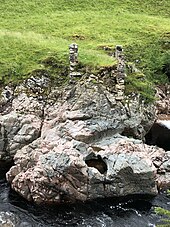James Hutton
He was one of the earliest proponents of what in the 1830s became known as uniformitarianism, the science which explains features of the Earth's crust as the outcome of continuing natural processes over the long geologic time scale.
Hutton also put forward a thesis for a 'system of the habitable Earth' proposed as a deistic mechanism designed to keep the world eternally suitable for humans,[5] an early attempt to formulate what today might be called one kind of anthropic principle.
On 12 September 1749, James Hutton obtained his doctorate in medicine from Leiden University with a physico-medical thesis entitled Sanguine et Circulatione Microcosmi.
[10]: 2–3 In the early 1750s he moved to Slighhouses and set about making improvements, introducing farming practices from other parts of Britain and experimenting with plant and animal husbandry.
In a 1753 letter he wrote that he had "become very fond of studying the surface of the earth, and was looking with anxious curiosity into every pit or ditch or bed of a river that fell in his way".
The mathematician John Playfair described Hutton as having noticed that "a vast proportion of the present rocks are composed of materials afforded by the destruction of bodies, animal, vegetable and mineral, of more ancient formation".
While his farming activities continued, in 1764 he went on a geological tour of the north of Scotland with George Maxwell-Clerk,[12] ancestor of the famous James Clerk Maxwell.
Hutton was one of the most influential participants in the Scottish Enlightenment, and fell in with numerous first-class minds in the sciences including mathematician John Playfair, philosopher David Hume and economist Adam Smith.
Between 1767 and 1774 Hutton had close involvement with the construction of the Forth and Clyde canal, making full use of his geological knowledge, both as a shareholder and as a member of the committee of management, and attended meetings including extended site inspections of all the works.
[18] From 1791 Hutton suffered extreme pain from stones in the bladder and gave up field work to concentrate on finishing his books.
[18] Around 1747, he had a son by a Miss Edington, and though he gave his child, James Smeaton Hutton, financial assistance, he had little to do with the boy, who went on to become a post-office clerk in London.
[20] Hutton developed several hypotheses to explain the rock formations he saw around him, but according to Playfair he "was in no haste to publish his theory; for he was one of those who are much more delighted with the contemplation of truth, than with the praise of having discovered it".
After some 25 years of work,[21] his Theory of the Earth; or an Investigation of the Laws observable in the Composition, Dissolution, and Restoration of Land upon the Globe was read to meetings of the Royal Society of Edinburgh in two parts, the first by his friend Joseph Black on 7 March 1785, and the second by himself on 4 April 1785.
Hutton subsequently read an abstract of his dissertation Concerning the System of the Earth, its Duration and Stability to Society meeting on 4 July 1785,[22] which he had printed and circulated privately.
[23] In it, he outlined his theory as follows; The solid parts of the present land appear in general, to have been composed of the productions of the sea, and of other materials similar to those now found upon the shores.
The existence of angular unconformities had been noted by Nicolas Steno and by French geologists including Horace-Bénédict de Saussure, who interpreted them in terms of Neptunism as "primary formations".
He later wrote of how he "rejoiced at my good fortune in stumbling upon an object so interesting in the natural history of the earth, and which I had been long looking for in vain."
[31] In the Spring of 1788 he set off with John Playfair to the Berwickshire coast and found more examples of this sequence in the valleys of the Tour and Pease Burns near Cockburnspath.
It was titled Theory of the Earth; or an Investigation of the Laws observable in the Composition, Dissolution, and Restoration of Land upon the Globe and appeared in Transactions of the Royal Society of Edinburgh, vol.
[42] Its 2,138 pages prompted Playfair to remark that "The great size of the book, and the obscurity which may justly be objected to many parts of it, have probably prevented it from being received as it deserves."
[44] James Lovelock, who developed the Gaia hypothesis in the 1970s, cites Hutton as saying that the Earth was a superorganism and that its proper study should be physiology.
[45] Hutton also advocated uniformitarianism for living creatures – evolution, in a sense – and even suggested natural selection as a possible mechanism affecting them: Hutton gave the example that where dogs survived through "swiftness of foot and quickness of sight... the most defective in respect of those necessary qualities, would be the most subject to perish, and that those who employed them in greatest perfection... would be those who would remain, to preserve themselves, and to continue the race".
[42] Though he saw his "principle of variation" as explaining the development of varieties, Hutton rejected the idea that evolution might originate species as a "romantic fantasy", according to palaeoclimatologist Paul Pearson.
[46] Influenced by deism,[47] Hutton thought the mechanism allowed species to form varieties better adapted to particular conditions and provided evidence of benevolent design in nature.










